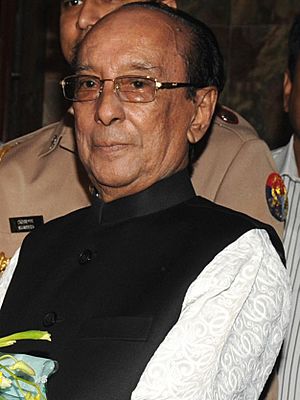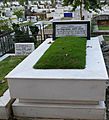Zillur Rahman facts for kids
Quick facts for kids
Zillur Rahman
|
|
|---|---|
|
জিল্লুর রহমান
|
|

Rahman in 2011
|
|
| President of Bangladesh | |
| In office 12 February 2009 – 20 March 2013 |
|
| Prime Minister | Sheikh Hasina |
| Preceded by | Iajuddin Ahmed |
| Succeeded by | Mohammad Abdul Hamid |
| Minister of Local Government and Co-operatives | |
| In office 23 January 1996 – 15 July 2001 |
|
| Personal details | |
| Born |
Mohammed Zillur Rahman
9 March 1929 Bhairab, Bengal Presidency, British India |
| Died | 20 March 2013 (aged 84) Singapore |
| Resting place | Banani graveyard, Dhaka |
| Nationality | British Indian (1927–1947) Pakistani (1947–1971) Bangladeshi (1971–2013) |
| Political party | Awami League |
| Other political affiliations |
Grand Alliance (2008–2013) |
| Spouse |
Ivy Rahman
(m. 1958; died 2004) |
| Children | Nazmul Hasan Papon |
| Education | MS (history) |
| Alma mater | Dhaka College University of Dhaka |
Mohammed Zillur Rahman (born March 9, 1929 – died March 20, 2013) was the President of Bangladesh from 2009 to 2013. He was also a very important member of the Awami League political party. He was the third president of Bangladesh to pass away while in office. He was the first one to die from natural causes.
Contents
Early Life and Education
Zillur Rahman was born on March 9, 1929, in Bhairab Upazila, which is in the Kishoreganj District. His father, Meher Ali Miyan, was a lawyer. He was also the Chairman of the Mymensingh Local Board.
Rahman started his schooling at Bhairab Model Govt. Primary School. In 1946, he finished high school from Bhairab K. B. High School. He then earned his Intermediate of Arts (IA) degree in 1947 from Dhaka College. In 1954, he received his Master of Arts (MA) degree in History. He also earned an LL.B. degree (a law degree) from Dhaka University.
Political Journey
Rahman became close with Sheikh Mujibur Rahman during a campaign in 1947. He took part in the Bengali language movement of 1952. This movement fought for Bengali to be recognized as an official language. He even organized a student meeting at Dhaka University in 1952 for this cause.
In 1953, Dhaka University tried to expel him for his role in the language movement. But students protested, and the order was cancelled. He was a key person in the 1954 election for the Mymensingh region. He also led the Awami Swechchhasebak League, which was connected to the Awami League. In 1956, he became the President of the Awami League in Kishoreganj.
Entering Parliament
Rahman was elected as a member of parliament in the 1970 national elections of Pakistan. During the Bangladesh Liberation War, he was active in the government that was formed outside the country. He also wrote for a newspaper called Daily Joy Bangla.
After the war, Rahman became the General Secretary of the Awami League in 1972. He was elected to parliament again in 1973. In 1974, he was re-elected as the General Secretary of the Awami League. He was arrested and spent four years in prison after Sheikh Mujibur Rahman passed away. In 1981, he became a Presidium Member of the Awami League. He was elected to parliament in 1986 and was imprisoned again that same year. In 1992, he was again made the General Secretary of the Awami League.
Minister and Party Leader
From 1996 to 2001, Rahman served as the Minister of Local Government, Rural Development and Co-operatives. He was also the deputy leader of parliament during this time. He was re-elected as the General Secretary of Bangladesh Awami League in 1997. In 2001, he was re-elected to Parliament.
His wife, Ivy Rahman, passed away in the 2004 Dhaka grenade attack. She was also an important leader in the Awami League. Rahman served as the temporary President of the Bangladesh Awami League when Sheikh Hasina was not able to lead the party. He was re-elected to Parliament in 2008.
Presidency
Zillur Rahman became the 19th president of Bangladesh on February 12, 2009. He was elected without anyone running against him. In 2009, he talked about the global economic slowdown. He stressed how important it was for Bangladesh to be part of the global economy.
He was also the Chief Scout of Bangladesh. He was happy that Bangladesh became the 5th largest scout country in the world during his time as president. As President, he was the Supreme Commander of the Bangladesh Armed Forces. He wanted the Armed Forces to become more modern. He also called for better connections between the Air Forces of countries in South Asia.
On September 27, 2010, Rahman appointed Justice A. B. M. Khairul Haque as the 19th chief justice of Bangladesh. In 2012, he asked Islamic countries to encourage Myanmar to take back Rohingya refugees. He also called for more trade and diplomatic ties with Cuba.
Personal Life
Zillur Rahman was married to Ivy Rahman. She was also a politician in the Awami League. Ivy passed away in the 2004 Dhaka grenade attack. They had one son, Nazmul Hassan Papon, and two daughters, Tania Bakht and Tanima Bakht. Their son, Papon, is the president of the Bangladesh Cricket Board. He is also a managing director at Beximco Pharma and a Member of Parliament.
Illness and Death
Zillur Rahman passed away at Mount Elizabeth Hospital in Singapore on March 20, 2013. He was 84 years old. He had been flown to Singapore by an air ambulance on March 10 because of a serious lung infection. He had been admitted to a hospital in Dhaka the day before, which was his 84th birthday. In Singapore, he was treated for kidney and breathing problems.
Bangladesh's High Commissioner in Singapore announced his passing. His children were with him when he died. While he was ill, Parliamentary Speaker Abdul Hamid became the acting president. A presidential spokesperson later announced three days of national mourning in Bangladesh. Zillur Rahman was buried in Dhaka's Banani graveyard.
After his death, Prime Minister Sheikh Hasina said she was deeply saddened. She called his death "an irreparable loss to the country and its people." In 2013, Hasina announced that the Mirpur-Airport Road Flyover would be named after him.
Images for kids
See also
 In Spanish: Zillur Rahman para niños
In Spanish: Zillur Rahman para niños




